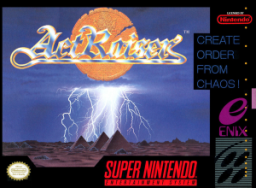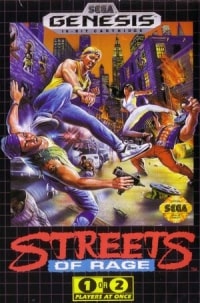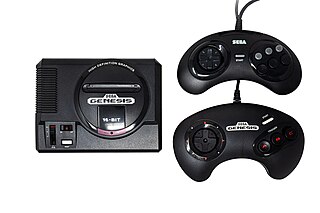
The Neo Geo, stylized as NEO•GEO and also written as NEOGEO, is a ROM cartridge-based arcade system board and fourth-generation home video game console released on April 26, 1990, by Japanese game company SNK Corporation. It was the first system in SNK's Neo Geo family.

Chiptune is a style of electronic music made using the programmable sound generator (PSG) sound chips or synthesizers in vintage arcade machines, computers and video game consoles. The term is commonly used to refer to tracker format music using extremely basic and small samples that an old computer or console could produce, as well as music that combines PSG sounds with modern musical styles. It has been described as "an interpretation of many genres" since any existing song can be arranged in a chiptune style defined more by choice of instrument and timbre than specific style elements.
Motion JPEG is a video compression format in which each video frame or interlaced field of a digital video sequence is compressed separately as a JPEG image.

The YM2612, a.k.a. OPN2, is a sound chip developed by Yamaha. It is a member of Yamaha's OPN family of FM synthesis chips, and is derived from the YM2203.
Video game music (VGM) is the soundtrack that accompanies video games. Early video game music was once limited to sounds of early sound chips, such as programmable sound generators (PSG) or FM synthesis chips. These limitations have led to the style of music known as chiptune, which became the sound of the first video games.
Ys is a series of action role-playing games developed by Nihon Falcom. The series chronicles the life of the adventurer, Adol Christin.
Full-motion video (FMV) is a video game narration technique that relies upon pre-recorded video files to display action in the game. While many games feature FMVs as a way to present information during cutscenes, games that are primarily presented through FMVs are referred to as full-motion video games or interactive movies.

ActRaiser is a 1990 video game developed by Quintet and published by Enix for the Super Nintendo Entertainment System, It combines traditional side-scrolling platforming and sections with city building and god game elements. A sequel, ActRaiser 2, was released for the Super NES in 1993. In 2007, ActRaiser became available on the Wii's Virtual Console download service in Europe, North America, and Japan. A version of the game was also released for European mobile phones in 2004. A remake, Actraiser Renaissance, was released for several platforms in 2021.
The digital sound revolution refers to the widespread adoption of digital audio technology in the computer industry beginning in the 1980s.

Streets of Rage is a beat 'em up game developed and published by Sega for the Genesis in 1991. Players control one of three former police officers turned vigilantes who battle a crime syndicate. Streets of Rage establishes many conventions of the Streets of Rage series, such as two-player cooperative play and an acclaimed techno soundtrack from composer Yuzo Koshiro. It was ported for the Game Gear, Sega CD and Master System and has been rereleased as part of various compilations and on download services.
Nihon Falcom Corporation (日本ファルコム株式会社) is a Japanese video game developer, best known for their Ys, The Legend of Heroes, and Trails series. The company was founded in March 1981, making them one of the oldest active video game companies. They are credited with pioneering the action role-playing and Japanese role-playing game genres, as well as popularizing the use of personal computers in Japan.

The Revenge of Shinobi, released in Japan as The Super Shinobi, is a hack-and-slash action video game developed and published by Sega in 1989. It was the first Shinobi game developed for the Sega Genesis, and was later released on the coin-operated version of that console, the Mega-Tech.

Yuzo Koshiro is a Japanese composer and sound programmer. He is often regarded as one of the most influential innovators in chiptune and video game music, producing music in a number of genres including rock, jazz, symphonic, and various electronic genres such as house, electro, techno, trance, and hip hop.

Quintet Co., Ltd. was a Japanese video game developer, founded in April 1989. The company name is derived from musical terminology, as well as five elements of game design—planning, graphics, sound, programming and producing. Quintet was most active in the 1990s, when it had a strong relationship with Enix ; the company was also a member of the GD-NET group of Sega Saturn developers. Quintet has not been active since the 2000s and is likely defunct.

Streets of Rage 2, known as Bare Knuckle II in Japan, is a 1992 side-scrolling beat 'em up video game published by Sega for the Genesis/Mega Drive. A sequel to Streets of Rage (1991), the characters Axel Stone and Blaze Fielding return while the game also introduces two new characters: Max Thunder, and Eddie "Skate" Hunter, the younger brother of Adam Hunter from the first game.
A mixed mode CD is a compact disc which contains both data and audio in one session. Typically the first track is a data track while the rest are audio tracks. The most common use for mixed mode CDs is to add CD-quality audio to video games on a CD.

Ys I: Ancient Ys Vanished, also known as Ys: The Vanished Omens or The Ancient Land of Ys, is a 1987 action role-playing game developed by Nihon Falcom. It is the first installment in the Ys series. Initially developed for the PC-8800 series by Masaya Hashimoto and Tomoyoshi Miyazaki, the game was soon ported to the Sharp X1, PC-98, FM-7, and MSX2 Japanese computer systems.

The music of the Streets of Rage series of beat 'em up games, released in the early 1990s, was primarily produced by Yuzo Koshiro.

Ys I & II is an action role-playing game compilation released by Hudson Soft and NEC for the PC Engine CD-ROM² in 1989 and TurboGrafx-CD in 1990. It consists of enhanced remakes of the first two Ys games by Nihon Falcom for the PC-8801 home computer in Japan. It was released as Ys Book I & II for the TurboGrafx-CD in North America in 1990, and was a pack-in title for the TurboDuo in 1992. Ys I & II was released on the Virtual Console in Japan in October 2007, and worldwide the following year.

The Sega Genesis Mini, known as the Mega Drive Mini in regions outside of North America, is a dedicated console modeled on the Sega Genesis. The Mini emulates the original console's 16-bit hardware, and includes 42 games made available through emulation software by M2. It was released in North America and Japan in September 2019 and in Europe and the Middle East in October 2019. A follow-up, Sega Genesis Mini 2, was released in October 2022 and includes 60 games from the Genesis and Sega CD.











